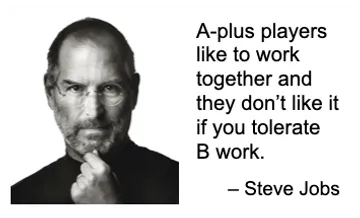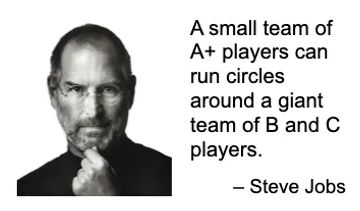The A-Player Principle: Why Settling is Not an Option in Hiring
Steve Jobs echoed a well-known principle: “A-level people hire A-level people, while B-level people hire C-level people.” Following this belief, Apple consistently seeks out A-players for pivotal roles. And for a good reason.

B-players tend to shy away from hiring those they perceive could outshine them. Their focus is often on delegation, not elevation, out of fear that the new recruit might surpass them. Instead of elevating their team, they prioritize their own standing by ensuring others don't rise above. This mindset often sees B-players entangled in corporate politics and leads to them hiring C-players.
In contrast, A-players actively scout for peers of the same caliber. They bond over shared insights, understand each other's motivations, and recognize one another's way of approaching challenges. By continuously challenging one another, they foster a culture of innovation. Simply put, A-players drive one another to excel.
For a fledgling software startup, having a team exclusively of A-players is crucial. But for larger entities, expecting every team member to be an A-player is unrealistic. If a sizable organization claims all their staff are top-tier, they might need a reality check.
So, how should organizations approach this?
Prioritize A-player leadership. Every tier of leadership and management should be helmed by A-players. These individuals, when given the right authority, will attract similarly-minded professionals and uphold recruitment standards. Any deviation from this standard should be promptly addressed. The quickest way to alienate A-players is by tolerating mediocrity. This will inevitably lead to a decline in work quality.

The mere presence of C-players can demotivate A-players. A discerning A-player quickly recognizes the detrimental effect of subpar performance. If these C-players aren't addressed, A-players might leave, usually succeeded by B-players. Such a decline might be gradual, but the slide toward mediocrity is relentless.
By positioning A-players in key roles, organizations can attract similar talent and enjoy exponential benefits. I've been fortunate to lead teams of A-players over the years. While they might be hard to come by and are motivated differently, their commitment, product quality, and contributions are unparalleled.

Allow A-players to be active in the recruitment process, trusting their instincts. If they express reservations about a candidate, heed their concerns. Every hiring misstep I've made stemmed from ignoring such instincts.
For managers, the pressure to recruit can be immense. But if a role demands an A-player, don't succumb to the lure of filling a vacancy for the sake of numbers. Actions often speak louder than words. If someone measures success merely by headcount, you might be dealing with a B or C-level mentality. True A-players are uncompromising in their standards.










